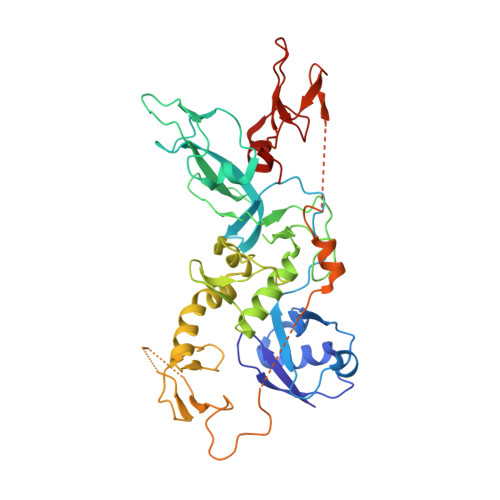Disruption of the autoinhibited state primes the E3 ligase parkin for activation and catalysis.
Kumar, A., Aguirre, J.D., Condos, T.E., Martinez-Torres, R.J., Chaugule, V.K., Toth, R., Sundaramoorthy, R., Mercier, P., Knebel, A., Spratt, D.E., Barber, K.R., Shaw, G.S., Walden, H.(2015) EMBO J 34: 2506-2521
- PubMed: 26254304
- DOI: https://doi.org/10.15252/embj.201592337
- Primary Citation of Related Structures:
5C1Z, 5C23 - PubMed Abstract:
The PARK2 gene is mutated in 50% of autosomal recessive juvenile parkinsonism (ARJP) cases. It encodes parkin, an E3 ubiquitin ligase of the RBR family. Parkin exists in an autoinhibited state that is activated by phosphorylation of its N-terminal ubiquitin-like (Ubl) domain and binding of phosphoubiquitin. We describe the 1.8 Å crystal structure of human parkin in its fully inhibited state and identify the key interfaces to maintain parkin inhibition. We identify the phosphoubiquitin-binding interface, provide a model for the phosphoubiquitin-parkin complex and show how phosphorylation of the Ubl domain primes parkin for optimal phosphoubiquitin binding. Furthermore, we demonstrate that the addition of phosphoubiquitin leads to displacement of the Ubl domain through loss of structure, unveiling a ubiquitin-binding site used by the E2~Ub conjugate, thus leading to active parkin. We find the role of the Ubl domain is to prevent parkin activity in the absence of the phosphorylation signals, and propose a model for parkin inhibition, optimization for phosphoubiquitin recruitment, release of inhibition by the Ubl domain and engagement with an E2~Ub conjugate. Taken together, this model provides a mechanistic framework for activating parkin.
Organizational Affiliation:
MRC Protein Phosphorylation and Ubiquitylation Unit, College of Life Sciences University of Dundee, Dundee, UK.


















